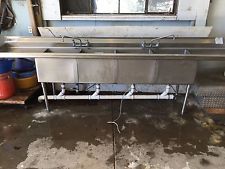You really didn’t need to do a study.
 Toronto proved as much in 2004ish, but I’ve been binge-watching The Crown to try and understand my predecessor’s inkling for things British.
Toronto proved as much in 2004ish, but I’ve been binge-watching The Crown to try and understand my predecessor’s inkling for things British.
The UK Food Standards Agency has published a new Science Report by its Chief Scientific Adviser Professor Guy Poppy. In his seventh Report, Professor Poppy looks at the Food Hygiene Rating Scheme (FHRS), and its impact on food safety especially where the scheme is mandatory.
Been there. Done that.
Professor Poppy said: ‘The Food Hygiene Rating Scheme has been a significant development for food safety and one which has delivered tangible benefits for consumers across the country. The scheme has empowered people, helping them to choose to eat in places with higher ratings. This in turn has pushed restaurants and other food businesses to drive up hygiene standards to attract more customers. I’ve also been encouraged that our research has linked higher ratings to lower levels of microbes found in food businesses, ultimately lowering the risk to consumers from foodborne illness.
Mandatory display of hygiene ratings has been successful in Wales and Northern Ireland and I am pleased that the FSA remains committed to seeing these benefits also realised in England.’
Since the introduction of FHRS in 2010 there has been continued improvement in standards of food hygiene at places people choose to eat out or buy food. There are now over 430,000 food hygiene ratings published at food.gov.uk/ratings.
Of those food businesses, 67% achieved the top rating of ‘5 – very good’ and 95% were rated ‘3 – generally satisfactory’ or better. In Wales and Northern Ireland, food businesses are legally required to display their food hygiene rating. This mandatory requirement has been in place in Wales since 2013 and in Northern Ireland since 2016. Evidence so far has shown that mandatory display has driven improved and sustained food safety compliance by the businesses.
The FSA is committed to introducing similar mandatory display of ratings at food outlets in England. There is an increasing call for this, and latest research indicates that 84% of consumers think that businesses should have to display their food hygiene rating at their premises.
Looking to the future the FSA is improving the way food businesses are regulated, with the aim of developing a sustainable system fit for the 21st century. This includes building on the success of FHRS by strengthening its robustness and resilience and introducing mandatory display.
 You’re not royalty. Stop writing like one.
You’re not royalty. Stop writing like one.
And as long as FSA keeps publishing BS advice, like it did, yet again this year in its annual Let’s Talk Turkey briefing, that stated, “Check that: the meat is steaming hot throughout; there is no pink meat visible when you cut into the thickest part and meat juices run clear” I will continue to make fun of your country and customs.
FSA is neither science nor evidence-based.
Filion, K. and Powell, D.A. 2009. The use of restaurant inspection disclosure systems as a means of communicating food safety information. Journal of Foodservice 20: 287-297.
The World Health Organization estimates that up to 30% of individuals in developed countries become ill from food or water each year. Up to 70% of these illnesses are estimated to be linked to food prepared at foodservice establishments. Consumer confidence in the safety of food prepared in restaurants is fragile, varying significantly from year to year, with many consumers attributing foodborne illness to foodservice. One of the key drivers of restaurant choice is consumer perception of the hygiene of a restaurant. Restaurant hygiene information is something consumers desire, and when available, may use to make dining decisions.
Filion, K. and Powell, D.A. 2011. Designing a national restaurant inspection disclosure system for New Zealand. Journal of Food Protection 74(11): 1869-1874
The World Health Organization estimates that up to 30% of individuals in developed countries become ill from contaminated food or water each year, and up to 70% of these illnesses are estimated to be linked to food service facilities. The aim of restaurant inspections is to reduce foodborne outbreaks and enhance consumer confidence in food service. Inspection disclosure systems have been developed as tools for consumers and incentives for food service operators. Disclosure systems are common in developed countries but are inconsistently used, possibly because previous research has not determined the best format for disclosing inspection results. This study was conducted to develop a consistent, compelling, and trusted inspection disclosure system for New Zealand. Existing international and national disclosure systems were evaluated. Two cards, a letter grade (A, B, C, or F) and a gauge (speedometer style), were designed to represent a restaurant’s inspection result and were provided to 371 premises in six districts for 3 months. Operators (n = 269) and consumers (n = 991) were interviewed to determine which card design best communicated inspection results. Less than half of the consumers noticed cards before entering the premises; these data indicated that the letter attracted more initial attention (78%) than the gauge (45%). Fifty-eight percent (38) of the operators with the gauge preferred the letter; and 79% (47) of the operators with letter preferred the letter. Eighty-eight percent (133) of the consumers in gauge districts preferred the letter, and 72% (161) of those in letter districts preferring the letter. Based on these data, the letter method was recommended for a national disclosure system for New Zealand.
 The hope is to cut down on foodborne illnesses.
The hope is to cut down on foodborne illnesses.










